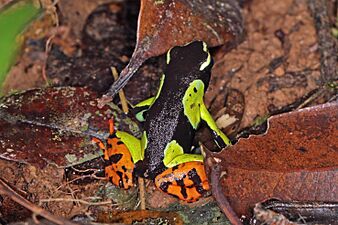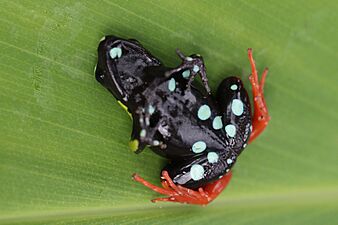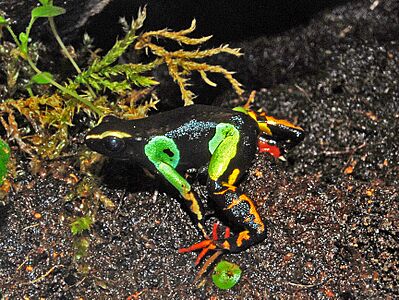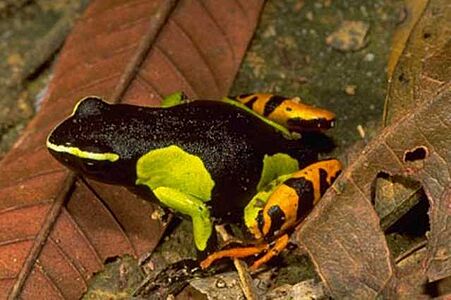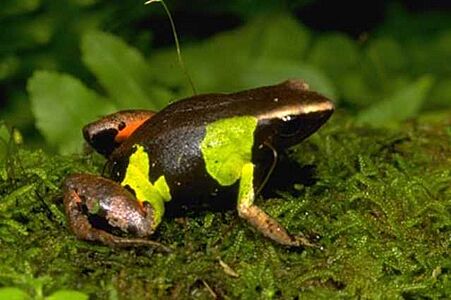Mantella baroni facts for kids
Quick facts for kids Mantella baroni |
|
|---|---|
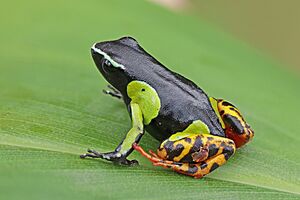 |
|
| Ranomafana National Park | |
| Conservation status | |
| Scientific classification | |
| Genus: |
Mantella
|
| Species: |
baroni
|
| Synonyms | |
|
Phrynomantis maculatus Thominot, 1889 |
|
Mantella baroni is a small, colorful, and poisonous frog. It's often known as Baron's mantella, the variegated golden frog, or the Madagascar poison frog. This frog is part of the Mantellidae family.
A scientist named George Albert Boulenger first described this species in 1888. He named it after Richard Baron, a botanist and missionary. Richard Baron collected and studied these frogs in Madagascar.
Contents
Where Baron's Mantella Lives and Its Home
Like other frogs in its family, Mantella baroni lives only in Madagascar. This means it is endemic to the island. Scientists believe these frogs arrived in Madagascar about 76 to 87 million years ago. They then developed into many different species across the island. These frogs are related to frogs from Asia. This suggests they likely traveled from Asia to Madagascar a long time ago.
Mantella baroni is one of about 220 frog species found only in Madagascar. About 15 of these are from the Mantella group. This frog lives in a fairly large area in East-Central Madagascar. This area stretches from Fierenana in the north to Andringitra in the south.
Its natural habitats include moist lowland forests and moist mountain forests. It also lives near rivers and in areas where forests used to be. These frogs usually prefer to live at heights between 600 and 1200 meters above sea level.
Conservation Status
The IUCN (International Union for Conservation of Nature) listed Mantella baroni as a Least Concern species in 2016. This is because it lives in a wide area. However, we don't know exactly how its population is changing. It might be in danger from several things that cause habitat loss.
These threats include human activities like building new towns and factories. Cutting down trees for timber and logging also harms their homes. Farming also takes away their natural forest habitat. This frog is also listed in CITES Appendix II. This means its trade is controlled to prevent it from becoming endangered.
What Baron's Mantella Looks Like
This frog is usually 28–32 mm long when it's fully grown. This makes it one of the largest frogs in its group of 16 species. Only some Mantella viridis frogs are bigger. Other Mantella species are typically 18–31 mm long.
Female Mantella baroni frogs are usually a bit larger than males. Females are 28–32 mm, while males are 24–28 mm. This size difference becomes clear after they are about 10–12 months old.
Most Mantella baroni frogs have special features that help tell them apart. They have a light line above their eyes. Their back legs have "tiger-like" orange and black stripes. You can see these markings in the pictures above.
However, these frogs can look quite different from each other. Their front legs can be light green, bright orange, or yellow. Because of these differences, they are sometimes mistaken for Mantella cowanii when sold.
Their front legs and upper back legs are yellow to greenish. This color continues up their sides into a large, rounded blotch. This looks very similar to another frog called the Mantella madagascariensis, or painted mantella. Both species have these colorful blotches that stand out against their black backs. Their legs are also striking orange and black. This makes it hard for people to tell them apart.
- Very similar species:
The easiest way to tell them apart is to look at the painted mantella's throat. It has a sky-blue, horseshoe-shaped mark. The Baron's mantella does not have bright marks on its lower back legs. Because they look so similar, the Baron's mantella is sometimes also called a "painted mantella." But remember, the painted mantella is a completely different species.
As you can see in the pictures, M. baroni has very bright colors on its front legs, back legs, and above its eyes. These bright colors are a warning sign. This is called aposematism. It tells predators that the frog is poisonous. All 16 species of Mantella frogs use bright colors as a warning. Some are less poisonous and use colors to trick predators.
These frogs look like the small poison dart frogs from Latin America. Poison dart frogs also use bright colors to warn predators. But Mantella frogs are only distantly related to them. When two unrelated species develop similar features, it's called convergent evolution.
Activity and Reproduction
Male M. baroni frogs make loud, short clicking sounds during the day. They do this to mark their area or to attract females for mating. Females can lay up to 130 eggs at one time. They almost always lay their eggs near water. When it rains, the tiny tadpoles that hatch are washed into the water.
Diet and Why They Are Poisonous
Mantella baroni is a very active hunter. It eats more prey than any other Mantella species. Its diet mainly consists of large arthropods. Most frogs hunt at night, but the Mantella baroni hunts during the day. It mostly eats ants, but also beetles, spiders, and mites.
When they eat mites, these frogs can produce strong poisons in their skin. These poisons are called alkaloids. This makes them toxic to animals that try to eat them. Their bright colors act as a warning sign. It tells predators that eating them could be dangerous and make them sick.
The amount of poison in their skin can change over time and in different places. It's always best not to touch these frogs without care. Human activities like pollution can affect how poisonous these frogs are. Pollution can kill their food sources, making their diet less varied. This means frogs in remote, untouched areas might be more poisonous.



